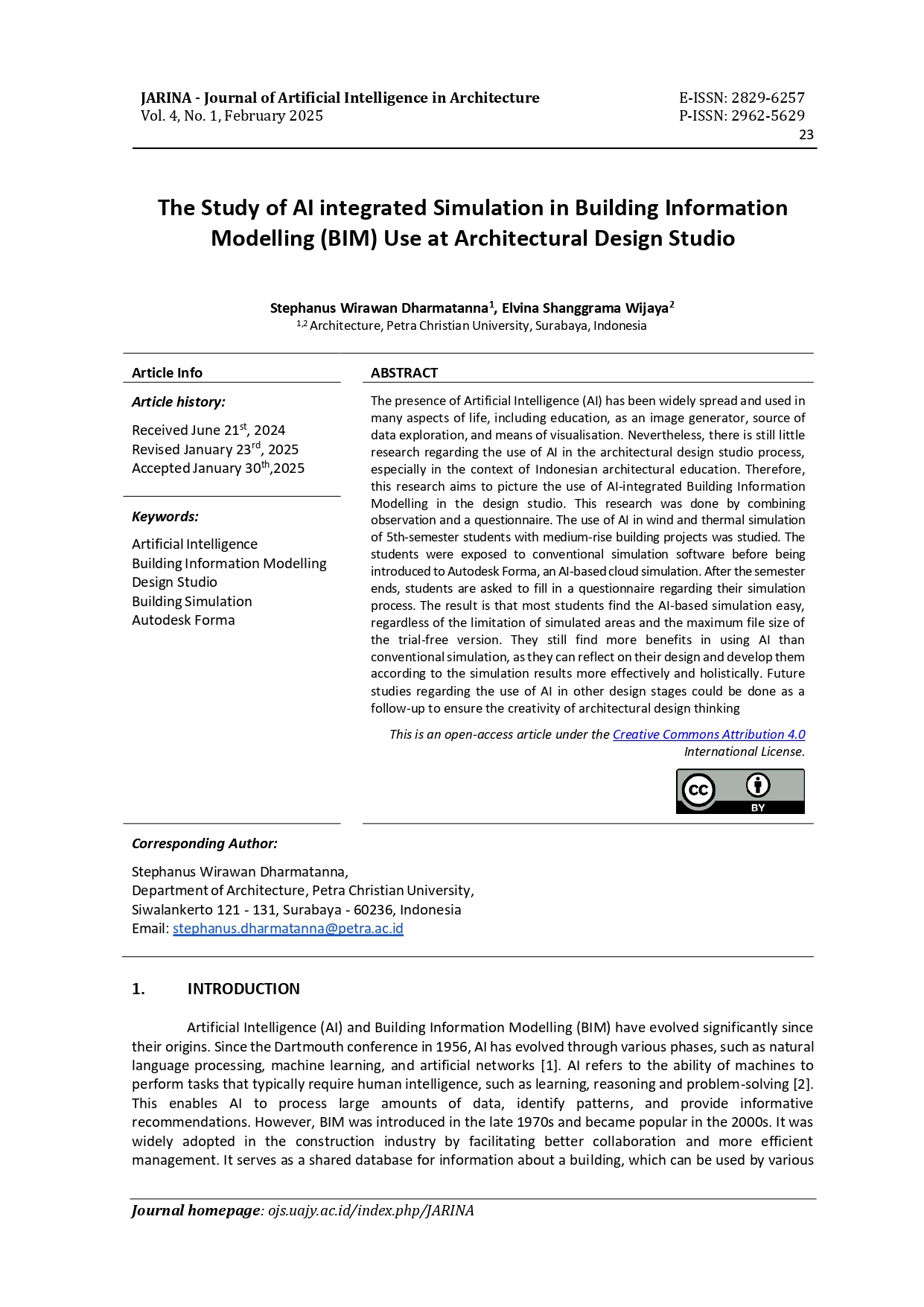The Study of AI integrated Simulation in Building Information Modelling (BIM) Use at Architectural Design Studio
DOI:
https://doi.org/10.24002/jarina.v4i1.9415Keywords:
Artificial Intelligence, Building Information Modelling, Design Studio, Building Simulation, Autodesk FormaAbstract
The presence of Artificial Intelligence (AI) has been widely spread and used in many aspects of life, including education, as an image generator, source of data exploration, and means of visualization. Nevertheless, the research regarding the use of AI in the Architectural design studio process is still few, especially in the context of Indonesian Architectural education. Therefore, this research aims to picture the use of AI integrated Building Information Modelling in the design studio. This research was done by combining observation and a questionnaire. The use of AI in wind and thermal simulation of 5th-semester students with medium-rise building projects was studied. The students were being exposed to conventional simulation software, before being introduced to Autodesk Forma, an AI based cloud simulation. After the semester ends, students are asked to fill in a questionnaire regarding their process of doing simulation. The result is that most of the students find the AI-based simulation easy, regardless of the limitation of simulated areas and the maximum file size of the trial-free version. They still find more benefits of using the AI Simulation compared to conventional one, as they can reflect on their design and develop them according to the simulation results more effectively and holistically. Future studies regarding the use of AI in other design stages could be done as a follow-up to ensure the creativity of architectural design thinking.
References
[1] B. Delipetrev, C. Tsinaraki, and U. Kostic, Historical Evolution of Artificial Intelligence. Publications Office of the European Union, 2020. Accessed: Jun. 15, 2024. [Online]. Available: https://publications.jrc.ec.europa.eu/repository/handle/JRC120469
[2] M. L. Castro Pena, A. Carballal, N. Rodríguez-Fernández, I. Santos, and J. Romero, “Artificial intelligence applied to conceptual design. A review of its use in architecture,” Automation in Construction, vol. 124, p. 103550, Apr. 2021, doi: 10.1016/j.autcon.2021.103550.
[3] J. Heaton, A. K. Parlikad, and J. Schooling, “Design and development of BIM models to support operations and maintenance,” Computers in Industry, vol. 111, pp. 172–186, Oct. 2019, doi: 10.1016/j.compind.2019.08.001.
[4] T. Gerrish, K. Ruikar, M. Cook, M. Johnson, M. Phillip, and C. Lowry, “BIM application to building energy performance visualisation and management: Challenges and potential,” Energy and Buildings, vol. 144, pp. 218–228, Jun. 2017, doi: 10.1016/j.enbuild.2017.03.032.
[5] A. Khudhair, H. Li, G. Ren, and S. Liu, “Towards Future BIM Technology Innovations: A Bibliometric Analysis of the Literature,” Applied Sciences, vol. 11, no. 3, Art. no. 3, Jan. 2021, doi: 10.3390/app11031232.
[6] M. S. Ng, K. Graser, and D. M. Hall, “Digital fabrication, BIM and early contractor involvement in design in construction projects: a comparative case study,” Architectural Engineering and Design Management, vol. 19, no. 1, pp. 39–55, Jan. 2023, doi: 10.1080/17452007.2021.1956417.
[7] L. Basarir, “Modelling AI in Architectural Education,” GAZI UNIVERSITY JOURNAL OF SCIENCE, vol. 35, Dec. 2021, doi: 10.35378/gujs.967981.
[8] M. P. Sopaheluwakan and T. J. W. Adi, “Adoption and implementation of building information modelling (BIM) by the government in the Indonesian construction industry,” IOP Conf. Ser.: Mater. Sci. Eng., vol. 930, no. 1, p. 012020, Sep. 2020, doi: 10.1088/1757-899X/930/1/012020.
[9] G. Zakharova, “Integration of emerging technologies in architectural education,” AIP Conference Proceedings, vol. 2657, no. 1, p. 020008, Oct. 2022, doi: 10.1063/5.0107192.
[10] S. K. Baduge et al., “Artificial intelligence and smart vision for building and construction 4.0: Machine and deep learning methods and applications,” Automation in Construction, vol. 141, p. 104440, Sep. 2022, doi: 10.1016/j.autcon.2022.104440.
[11] Z. Zhang, J. M. Fort, and L. Giménez Mateu, “Exploring the Potential of Artificial Intelligence as a Tool for Architectural Design: A Perception Study Using Gaudí’sWorks,” Buildings, vol. 13, no. 7, Art. no. 7, Jul. 2023, doi: 10.3390/buildings13071863.
[12] M. U. Mehmood, D. Chun, Zeeshan, H. Han, G. Jeon, and K. Chen, “A review of the applications of artificial intelligence and big data to buildings for energy-efficiency and a comfortable indoor living environment,” Energy and Buildings, vol. 202, p. 109383, Nov. 2019, doi: 10.1016/j.enbuild.2019.109383.
[13] S. Ceylan, “Artificial Intelligence in Architecture: An Educational Perspective,” presented at the International Conference on Computer Supported Education, SCITEPRESS, Apr. 2021, pp. 100–107. doi: 10.5220/0010444501000107.
[14] “Autodesk Forma | Forma Login | Software Price & Buy.” Accessed: Jun. 14, 2024. [Online]. Available: https://www.autodesk.com/products/forma/overview
[15] A. Bachrun, T. Zhen, and A. Cinthya Gani, “BUILDING ENVELOPE COMPONENT TO CONTROL THERMAL INDOOR ENVIRONMENT IN SUSTAINABLE BUILDING: A REVIEW,” SINERGI, vol. 23, pp. 79–98, Jun. 2019, doi: 10.22441/sinergi.2019.2.001.
[16] S. Mirrahimi, M. F. Mohamed, L. C. Haw, N. L. N. Ibrahim, W. F. M. Yusoff, and A. Aflaki, “The effect of the building envelope on the thermal comfort and energy saving for high-rise buildings in hot–humid climate,” Renewable and Sustainable Energy Reviews, vol. 53, pp. 1508–1519, Jan. 2016, doi: 10.1016/j.rser.2015.09.055.
[17] K. Negendahl, “Building performance simulation in the early design stage: An introduction to integrated dynamic models,” Automation in Construction, vol. 54, pp. 39–53, Jun. 2015, doi: 10.1016/j.autcon.2015.03.002.
[18] M. Palme, “What Architects want? Between BIM and Simulation Tools: An Experience Teaching Ecotect,” 2011.
[19] O. Popova, N. Silvestrova, and V. Koshel, “MODERN SOFTWARE FOR COMPUTER MODELING IN ARCHITECTURAL EDUCATION: Array,” Municipal economy of cities, vol. 1, no. 161, Art. no. 161, Mar. 2021.
[20] E. S. Wijaya and S. W. Dharmatanna, “COMPREHENSIVE ANALYSIS ON BIM LEARNING IN ARCHITECTURE UNDERGRADUATE STUDENTS IN INDONESIA,” MODUL, vol. 24, no. 2, pp. 63–70, Dec. 2024, doi: 10.14710/mdl.24.2.2024.63-70.

Downloads
Published
How to Cite
Issue
Section
License
Copyright (c) 2025 Stephanus Wirawan Dharmatanna, Elvina Shanggrama Wijaya

This work is licensed under a Creative Commons Attribution 4.0 International License.
Authors who publish with this journal agree to the following terms:
1.Authors retain copyright and grant the journal right of first publication with the work simultaneously licensed under a Creative Commons that allows others to share the work with an acknowledgement of the work's authorship and initial publication in this journal.
2.Authors are able to enter into separate, additional contractual arrangements for the non-exclusive distribution of the journal's published version of the work (e.g., post it to an institutional repository or publish it in a book), with an acknowledgement of its initial publication in this journal.
3.Authors are permitted and encouraged to post their work online (e.g., in institutional repositories or on their website) prior to and during the submission process, as it can lead to productive exchanges, as well as earlier and greater citation of published work (See The Effect of Open Access).
















